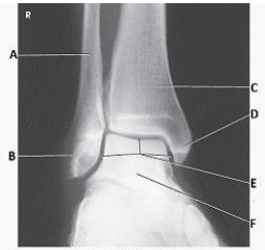A) 0 degrees.
B) 5 to 7 degrees cephalad.
C) 5 to 7 degrees caudad.
D) dependent upon the ASIS-to-tabletop measurement.
F) B) and C)
Correct Answer

verified
Correct Answer
verified
Multiple Choice
The talus articulates with how many bones?
A) One
B) Two
C) Three
D) Four
F) A) and C)
Correct Answer

verified
Correct Answer
verified
Multiple Choice
Which two of the following are required to position the knee correctly for the lateral projection of the patella? (Select all that apply.)
A) Patella is perpendicular to the IR
B) 20-degree flexion
C) Epicondyles are superimposed
D) 30-degree flexion
F) None of the above
Correct Answer

verified
Correct Answer
verified
Multiple Choice
All of the following forms the ankle mortise,except:
A) lateral malleolus of the fibula.
B) medial surface of the tibia.
C) inferior surface of the tibia.
D) medial malleolus of the tibia.
F) C) and D)
Correct Answer

verified
Correct Answer
verified
Multiple Choice
The second largest bone in the body is the:
A) hip.
B) tibia.
C) femur.
D) skull.
F) C) and D)
Correct Answer

verified
Correct Answer
verified
Multiple Choice
Where is the central ray directed for a lateral projection of the calcaneus?
A) 1 inch distal to the medial malleolus
B) 2 inches distal to the medial malleolus
C) 1 inch posterior to the medial malleolus
D) 2 inches posterior to the medial malleolus
F) B) and C)
Correct Answer

verified
Correct Answer
verified
Multiple Choice
Which two of the following methods are used to demonstrate the intercondylar fossa? (Select all that apply.)
A) Holmblad (PA axial)
B) Settegast (Tangential)
C) Camp-Coventry (PA axial)
D) Hughston (Tangential)
F) B) and D)
Correct Answer

verified
Correct Answer
verified
Multiple Choice
For a lateral projection of the ankle,the central ray must enter the:
A) navicular.
B) tibiofibular joint.
C) medial malleolus.
D) lateral malleolus.
F) A) and D)
Correct Answer

verified
Correct Answer
verified
Multiple Choice
The largest and strongest tarsal bone is the:
A) calcaneus.
B) navicular.
C) medial cuneiform.
D) lateral cuneiform.
F) B) and D)
Correct Answer

verified
Correct Answer
verified
Multiple Choice
On which aspect of the foot does the cuboid lie?
A) Lateral
B) Medial
C) Superior
D) Inferior
F) A) and C)
Correct Answer

verified
Correct Answer
verified
Multiple Choice
What anatomy is labeled with the letter D in the image below? 
A) Lateral malleolus
B) Medial malleolus
C) Talus
D) Tibiotalar joint
F) C) and D)
Correct Answer

verified
Correct Answer
verified
Multiple Choice
How much should the leg be flexed for a lateral projection of the knee?
A) 10 degrees
B) 45 degrees
C) 10 to 20 degrees
D) 20 to 30 degrees
F) None of the above
Correct Answer

verified
Correct Answer
verified
Multiple Choice
Which two of these are options for knee flexion for the tangential projection (Settegast method) of the patella when obtained with the patient in prone position? (Select all that apply.)
A) 50 degrees from the table
B) 50 degrees from the CR
C) As much as possible
D) Until the patella is perpendicular to the IR
F) A) and B)
Correct Answer

verified
Correct Answer
verified
Multiple Choice
How far should the IR or collimated field extend beyond the ankle or knee joint for an AP projection of the leg?
A) to 1 inch
B) 1 to 2 inches
C) 1 to 1inches
D) 2 to 2inches
F) A) and D)
Correct Answer

verified
Correct Answer
verified
Showing 141 - 154 of 154
Related Exams